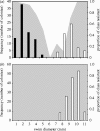The effect of a bacteriophage on diversification of the opportunistic bacterial pathogen, Pseudomonas aeruginosa
- PMID: 16006335
- PMCID: PMC1560335
- DOI: 10.1098/rspb.2005.3086
The effect of a bacteriophage on diversification of the opportunistic bacterial pathogen, Pseudomonas aeruginosa
Abstract
Pseudomonas aeruginosa is an opportunistic human pathogen that colonizes the lungs of cystic fibrosis (CF) patients. CF lungs often contain a diverse range of P. aeruginosa phenotypes, some of which are likely to contribute to the persistence of infection, yet the causes of diversity are unclear. While the ecological heterogeneity of the lung environment and therapeutic regimes are probable factors, a role for parasitic bacteriophage cannot be ruled out. Parasites have been implicated as a key ecological variable driving the evolution of diversity in host populations. PP7 drove cycles of morphological diversification in host populations of P. aeruginosa due to the de novo evolution of small-rough colony variants that coexisted with large diffuse colony morph bacteria. In the absence of phage, bacteria only displayed the large diffuse colony morphology of the wild-type. Further assays revealed there to be two distinct types of resistant bacteria; these had very different ecological phenotypes, yet each carried a cost of resistance.
Figures




References
-
- Abrams P.A. Character shifts of prey species that share predators. Am. Nat. 2000;156(Suppl. X):S45–S61. - PubMed
-
- Abrams P.A, Chen X. The effect of competition between prey species on the evolution of their vulnerabilities to a shared predator. Evol. Ecol. Res. 2002;4:897–909.
-
- Agrawal A.F. Phenotypic plasticity in the interactions and evolution of species. Science. 2001;294:321–326. - PubMed
-
- Blahova J, Hupkova M, Krcmery V., Sr. Phage F-116 transduction of antibiotic resistance from a clinical isolate of Pseudomonas aeruginosa. J. Chemother. 1994;6:184–188. - PubMed
Publication types
MeSH terms
Grants and funding
LinkOut - more resources
Full Text Sources
Other Literature Sources
